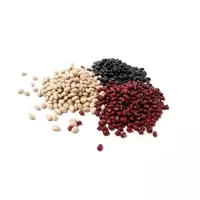Haricot

The culinary history of beans takes us 8 thousand years ago, when people first got acquainted with this bean crop. And today, no feast in Brazil and Mexico is complete without dishes made from beans. In Japan, for example, bean paste cakes are adored, while the English for breakfast usually have toasted sausages, crispy toast and beans in tomato sauce. The national dish of Georgia - lobio - is simply unthinkable without this product, with the summer version made from green beans and the winter version made from grains. In general, the colorful taste and beneficial properties of beans are known almost everywhere.
Types of beans
It is noteworthy that ordinary beans are divided into two types: green beans and husk varieties. The first type of bean includes green beans, which is also called asparagus. For culinary purposes, it is steamed or boiled in the usual way, baked in the oven, marinated, added to omelettes, stews, soups or salads.
White beans, which have a crumbly texture and a delicate creamy taste, represent the second type. As for red beans, which in some countries are called "Kidney, " this is how this type of bean also refers to hovering varieties. It is used, like white beans, in all kinds of meat dishes and stews.
Lima beans
azuki beans
The benefits of beans
The benefits of beans for the human body are due to its chemical composition. So, it contains starch, proteins that are easily absorbed by the body, amino acids, carbohydrates, many vitamins and especially minerals. The nutritional value and calorie content of beans make this type of legumes a rather satisfying product, in connection with which it is recommended to use it in case of lack of body weight, as well as for speedy recovery after severe diseases.
It has been scientifically proven that in terms of copper and zinc content, this natural product "overtakes" most vegetable crops. Sulfur in its composition also speaks of the benefits of beans, since this macronutrient helps with skin diseases, rheumatism, as well as intestinal infections. It is possible to list all the valuable properties of beans for a very long time, and perhaps this is why nutritionists attribute it to the 10 most useful foods for health.
Harm to beans
Speaking of the likely harm of beans, it is important to know that it can manifest itself in case of improper preparation of this product. So, in no case should you eat beans in raw form, due to the content of poisonous substances in it. In addition, even cooked beans are not recommended for elderly people, as well as in the case of diseases such as gastritis, colitis and stomach ulcer.
beans 298 kCal
Energy value of beans (Ratio of proteins, fats, carbohydrates - ju):
Proteins: 21 g (~ 84 kCal)
Fats: 2g (~ 18kCal)
Carbohydrates: 47g (~ 188kCal)
Energy ratio (bj | y): 28% | 6% | 63%
 Español
Español Français
Français Português
Português Русский
Русский 简体中文
简体中文 繁體中文
繁體中文 日本語
日本語 한국어
한국어 العربية
العربية Türkçe
Türkçe Қазақ
Қазақ Deutsch
Deutsch Italiano
Italiano Українська
Українська
